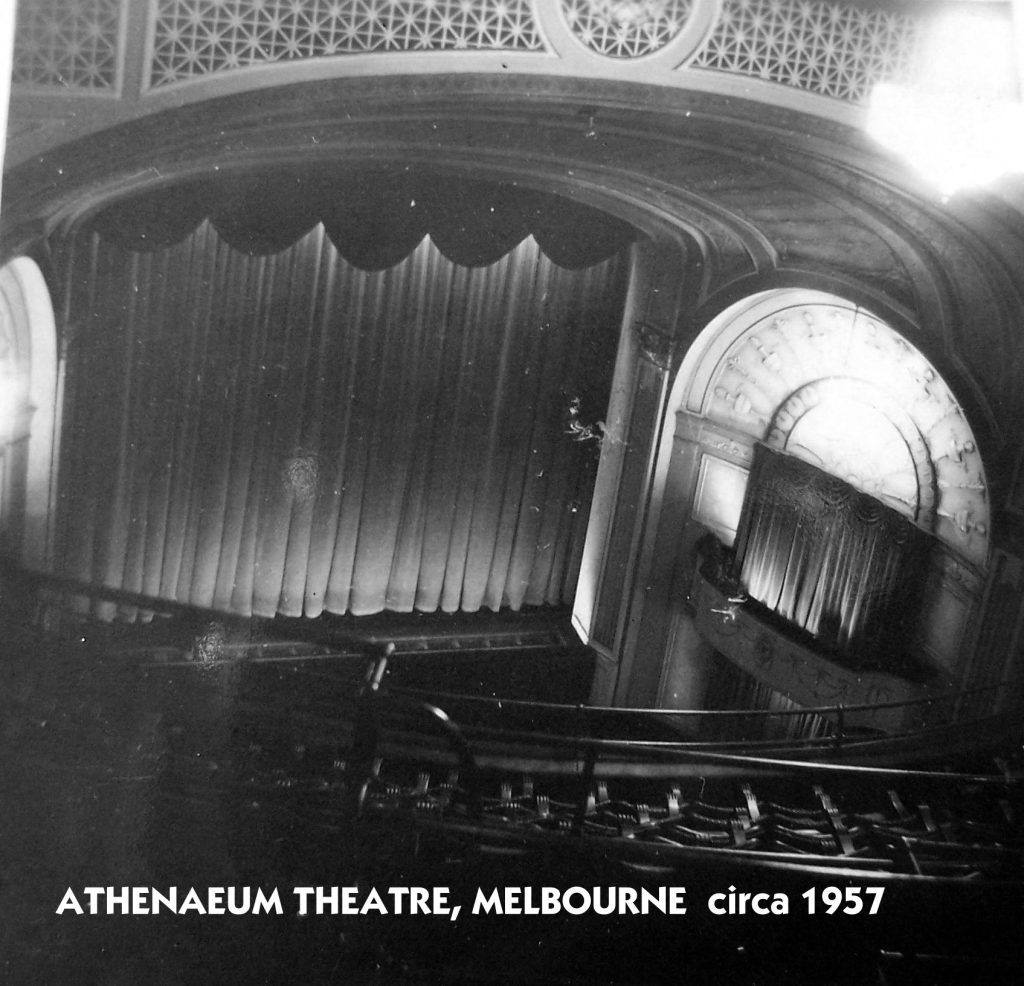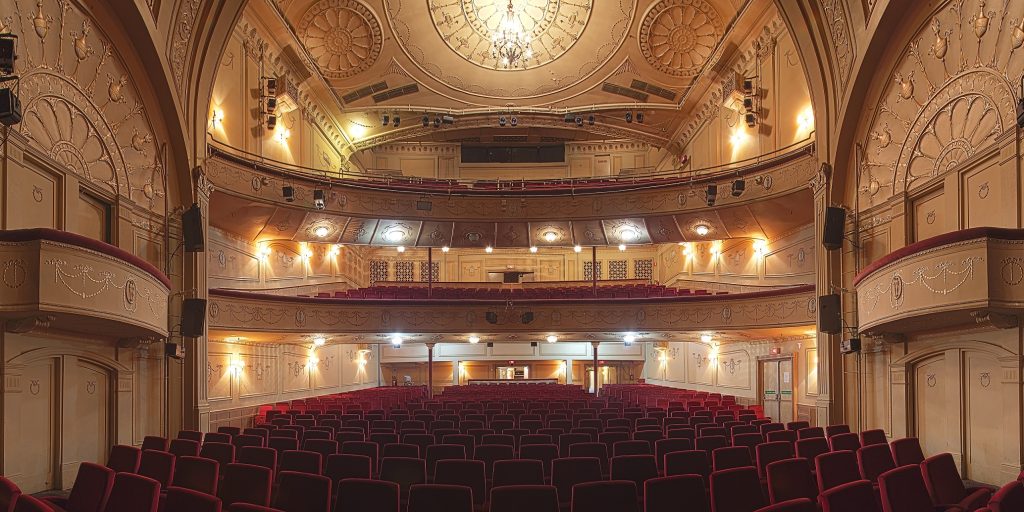The Melbourne Athenaeum Library will be closed from 4:00pm on Tuesday December 23. We will reopen at 10:00am Tuesday January 6.
We wish all our members a very festive holiday season.
There's something very special about an old theatre.
When you look around, you feel as though you've been here before. It's a bit like returning to a familiar, friendly lounge room. And you're not alone. There are hundreds of others here to keep you company, all intent, like you, to experience the magic of a shared live theatre experience.
At the Melbourne Athenaeum, it's been like this since 1842. Yes, that's how long the Athenaeum has been at the very heart of Melbourne. Think of how many people have been here before you. Maybe your parents, their parents, even perhaps your great, great grandparents came here – even though they probably wouldn't recognise it now.
As the years have tumbled by, the old place has changed a lot. When it first opened its welcoming doors, in 1842, the settlement it served was only a few years old. Back then it was called the Melbourne Mechanics' Institution – the 'hall' was a large room on the first floor. A much larger hall specifically designed for concerts, lectures and theatricals was added in 1872 on the ground floor – you can see the foundation stone, now relocated to the landing of the stairs that lead to the upper levels of the auditorium. Ten years later the Athenaeum was one of the first buildings to be connected to the city's electricity supply. An 1885-86 refurbishment included a small lecture hall – today's Athenaeum II – and that's also when the familiar façade was added, complete with its statue of Athena, the gift of a former lord mayor.
In 1890 the Athenaeum introduced Melburnians to the wonders of Mr Edison's talking machine; Henry Morton Stanley ('Dr Livingstone, I presume?') lectured here in 1892, and Mark Twain in 1895. Edison's Vitascope was demonstrated in 1896, and the Cinematographe in 1897. Three years later came newsreels of the Boer War. The Story of the Kelly Gang – claimed to be the world's first feature film – premiered here in 1906, followed by Robbery Under Arms (1907), For the Term of His Natural Life (1908) and The Squatter's Daughter (1910). In between movie seasons, Gregan McMahon presented important drama productions, including the Australian premieres of Chekhov's The Seagull, Louis Esson's The Time Is Not Yet Ripe, and Shaw's Man and Superman and Major Barbara. The great British actress Ellen Terry appeared here in 1914 – with her friend Dame Nellie Melba in the audience.
In 1924 entrepreneur Frank Talbot took a long lease of the Athenaeum Hall. With financial support from the notorious John Wren, Talbot engaged the extraordinarily prolific theatre architect Henry Eli White to create an intimate 'bijou' style three-level, live theatre within the walls of the old hall. The result was the beautiful auditorium so familiar to us all. It's a perfect example of White's trademark 'Adam' style; he used it in dozens of Australian theatres, most notably in the refurbishment of the Princess in 1922.

The Athenaeum Theatre began its new life on 23 December 1924 with a Melbourne Repertory Company production of J.M. Barrie's Dear Brutus. The theatre quickly settled into its new role as a home for live shows, mostly under the management of E.J. Carroll. The Australian stars of that era included Maggie Moore, Jack Cannot, Fifi Banvard, Pat Hanna and his famous 'Diggers' company, Tal Ordell (in an Australian play, Kangaroo Flat) and film star Louise Lovely. From England came dapper Basil Radford and, from the United States, spiritual singer Edna Thomas, song and dance act Lee White and Clay Smith, and the American comic actors John D. O'Hara and Harry Green. Green's season of the play Give and Take in 1925 gave the great Australian comedian Roy Rene 'Mo' a chance to show his versatility away from the vaudeville milieu.
On 2 February 1929 the Athenaeum introduced Melbourne to the 'talkies' with the first screenings of Al Jolson in The Jazz Singer. For the next forty years the Athenaeum Theatre was a cinema. In 1932 Frank Talbot announced that it would be 'the first all-British theatre in the Empire'. The policy was maintained, with an occasional exception, until the mid-1960s.
Among the theatre's more notable British films were Pygmalion (which notched up a 25-week run), The Way Ahead, This Happy Breed, Henry V, Blithe Spirit, The Way to the Stars, Brief Encounter and Odd Man Out. To add to the elegant ambience, patrons enjoyed musical interludes from Cecil Parkes and his Strad Trio, and afternoon teas were served in the stalls. On 11 June 1948 Olivier's Hamlet had its Australian premiere with Sir Laurence and his wife, Vivien Leigh, in the audience.
During the 1960s long runs became common: The Nun's Story (17 weeks), The Sundowners (29 weeks), The Longest Day (38 weeks), Hawaii (41 weeks), In the Heat of the Night (28 weeks) and Bedazzled (23 weeks). The Athenaeum Theatre also screened the first of the Pink Panther movies, the Beatles' films A Hard Day's Night and Help!, and made a hit with Zorba the Greek, which had failed to attract audiences during its first city run.
In 1970 Ken Brodziak's Aztec Services and Sydney-based Phillip Productions leased the Athenaeum, installed a licensed bar, and presented a series of live attractions: Forty Carats with Marti Stevens and Tommy Hanlon Jnr; Peggy Mount in The Bandwagon; Emlyn Williams in his Charles Dickens persona; and a satirical revue called Oh, Sir Henry! – a celebration of Victoria's controversial premier, Henry Bolte. By the end of the year, the Athenaeum was again a cinema.
In 1971 the distinguished British acress Anna Neagle, in town to star in the musical Charlie Girl, attended a special charity screening of one of her greatest films, Sixty Glorious Years, another of the Athenaeum's popular films.
The Athenaeum Theatre endured a few more years of mostly undistinguished movies until 1977, when the Melbourne Theatre Company moved in. New technical equipment was installed and the proscenium was reworked to enlarge the stage. The MTC's tenancy began on 17 March 1977 with The School for Scandal. The following year the upstairs hall became 'Athenaeum II'. The MTC's offerings over its nine-year occupancy included Robin Ramsay as Shylock in The Merchant of Venice (1977), 'Breaker' Morant (1978). Cinderella with Fred Parslow and Noel Ferrier as the Ugly Sisters (1979), Privates on Parade (1908), Frank Thring in The Man Who Came to Dinner (1980), Keith Michell's Pete McGinty and the Dreamtime (1981), Amadeus 1981), Garry McDonald in On Our Selection (1982) and A Midsummer Night's Dream with Bruce Spence and Bruce Myles (1984).
After the MTC moved to the Playhouse at the Arts Centre in 1984, the Athenaeum became available to other managements. The Sydney Theatre Company presented The Cobra with Robert Helpmann as Lord Alfred Douglas (1984) and The Doll Trilogy (1985) and Diane Cilento made her Melbourne debut in Agnes of God (1984).
In 1986 the Athenaeum was leased to the entrepreneurs Greg Hocking and Tim Woods; later Glenn Elston and Barry Janes joined the team and Tim Woods moved on. The new reign was launched with a team of New York comedians, then changed pace with June Salter in Crown Matrimonial. Comedians Rik Mayall, Ben Elton and Max Gillies followed. In 1987 came Wogs out of Work, a transfer from the Universal theatre that ran a record 21 weeks. In 1991 the government's Melbourne Planning Scheme provided $2.3 million for extensive renovations, including enlargement of the foyer and restoration of the proscenium and stage boxes.
After this the Athenaeum settled down to a wonderfully eclectic array of entertainment. Regular seasons by the Bell Shakespeare Company and occasional MTC transfers contrasted with a parade of star names unrivaled by any other Melbourne venue. Here, in discreet alphabetical order, are just some of them:
Bea Arthur, Steven Berkoff, Simon Callow, The Chaser, Julian Clary, Anh Do, Bob Downe, Judith Durham and the Seekers, Marianne Faithfull, Michael Feinstein, Nick Giannopoulos, Adam Hills, Dave Hughes, Barry Humphries, Jimeoin, Jean Kittson, Lano and Woodley, Leo McKern, Warren Mitchell, Julia Morris, Glynn Nicholas, Ross Noble, Pete Postlethwaite, Bernadette Robinson, Normie Rowe, Akmal Saleh, Glenn Shorrock, David Strassman, Richard Stubbs, Noel Tovey, John Waters, Ruby Wax, Susannah York.
There have been seasons by Compagnie Philippe Genty and Legs on the Wall, and notable productions like Five Guys named Moe, Boswell for the Defence, Hair, Mum's the Word, It's a Dad Thing, The Vagina Monologues, Hot Shoe Shuffle, Wogboys, Picasso at the Latin Agile, Educating Rita, Twelve Angry Men, Acropolis Now, Altar Boyz, Menopause the Musical and Shane Warne: the Musical and, yes, even Puppetry of the Penis.
But it is as a home for the opera that the Athenaeum has found its most surprising niche. What has become a grand tradition began in 1986 during Gian Carlo Menotti's first Melbourne Arts Festival: the Washington Opera Company's staging of a double bill of two of Menotti's short works, The Medium and The Telephone.
In 1993 Chamber Made Opera used the Athenaeum for the world premiere of Medea with music by Gordon Kerry and a libretto by Justin Macdonnell, based on stories by the Roman dramatist Seneca. Melbourne soprano, Merlyn Quaife had the title role.
In 1999 Opera Australia presented The Barber of Seville. Later that year Melbourne City Opera staged A Masked Ball with Greg Hocking conducting. MCO went on to present Falstaff and Il Trovatore in 2001 and Cavalleria Rusticana, Gianni Schicchi and Tosca in 2002, before moving to the Comedy.
Greg Hocking was one of the team that created Melbourne Opera, a new company dedicated to staging a mixture of the standard repertoire and new works at professional standard and at affordable ticket prices. The Athenaeum generously provided the venue and the enterprise swiftly garnered support from benefactors and audiences.
On 5 June 2003 Melbourne Opera debuted with a sparkling new production of La Traviata. Greg Hocking conducted and Blair Edgar directed, with Helen Noonan as Violetta and Stephen Smith as Alfredo.
Since then, Melbourne Opera has presented around three productions a year at the Athenaeum. It also became the launching pad for its now extensive touring program.
Although the theatre's 850-seat intimacy allowed audiences to enjoy opera in a way impossible in a larger venue, productions were hampered by the lack of a traditional orchestra pit. This was addressed in 2009 when the Athenaeum received $877,000 in Federal Government stimulus funding. The money was used to upgrade the foyer, replace the seats and carpets – and construct an orchestra pit capable of catering for 50 musicians. The new pit was ready for the first Melbourne Opera's performance of The Barber of Seville on 10 March 2010.
The results were acclaimed by audiences and reviewers. In The Age, John Slavin said: 'Housed in their new pit, the Melbourne Opera Orchestra, conducted by Greg Hocking, brings out Rossini's dazzling instrumental colouration.' Simon Parris, reporting online for Theatre People said: 'The gleaming wood and red velvet pit is a welcome addition to this grand old space, and the promised new seats and carpets are eagerly awaited to further enhance the experience. Placing the orchestra in the pit has made a marked difference to the sound quality, with the stalls now experiencing a balanced sound mix along with the dress circle and balcony. And what a glorious sound it is.'

So here we are, after all those years; so much history, so many memories; all those shows, all those people who've come and gone.
That, then, in all its colour and its convolutions, is the story so far.
Frank Van Straten OAM
Based on Program notes for the Melbourne Opera in 2011.
The author thanks Ralph Marsden of Theatre Heritage Australia, without whose research into the Athenaeum's history this article would not have been possible.